Palazzo Farnese in Caprarola: a jewel in the Tuscia Viterbese area
Palazzo Farnese in Caprarola: history, architecture, galleries and gardens. Discover what to see, how to get there and all the useful information.If you love history, art and architecture, the Palazzo Farnese, in Caprarola, also known as Villa Farnese, is definitely worth a visit. It is a jewel in the Tuscia Viterbese area with its roots in the Italian Renaissance.
Located in the upper part of the village, the palace can only be accessed through a street, Via Dritta, which perfectly divides the burg in two. Thus, it dominates from above creating astonishment in all visitors who arrive. Symbol of prestige and power, this majestic house is home to a vast cultural and artistic history.
Keep reading to find out what to see in Palazzo Farnese and in beautiful Caprarola!
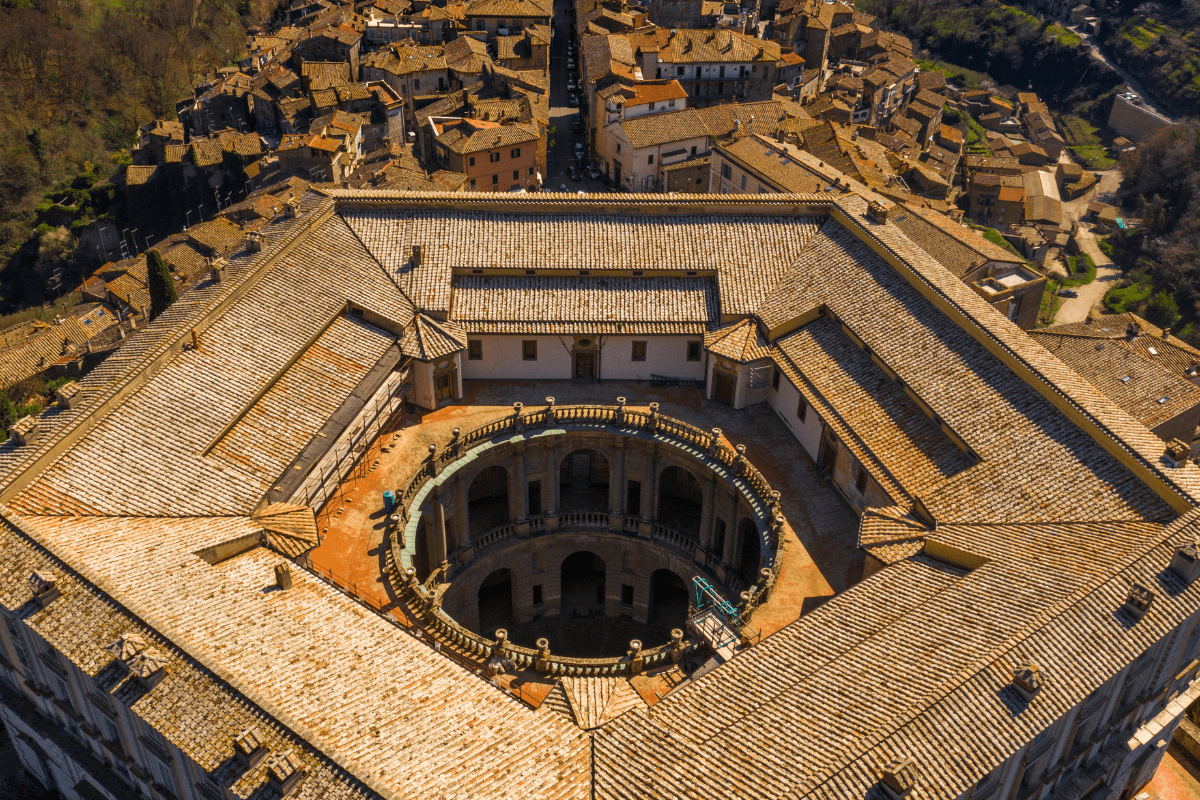
Palazzo Farnese seen from above. You can see its pentagonal shape and the Via Dritta
The history of Palazzo Farnese
It all began in the 16th century, when Cardinal Alessandro Farnese fell in love with what was then the small village of Caprarola and decided to buy it in order to build a lavish fortified residence to demonstrate the power of his family.
The Farnese family was among the most prestigious families of Italian Renaissance and Baroque, playing a crucial role in Italian politics, culture and arts. Its origin is in Tuscia and the members are known above all for their influence in the Catholic Church, since two of them, Alessandro Farnese (Pope Paul III) and his nephew Duke Alessandro Farnese (Pope Paul IV) reached the highest ecclesiastical office. Alessandro Farnese took up his grandfather's project by commissioning the architect Jacopo Barozzi da Vignola to build this extraordinary residence.
In 1559 the works began and, as Alessandro Farnese the Younger was an erudite man who surrounded himself with so many men of culture, he called upon the most eminent painters and the most prestigious architects to build the magnificent Palazzo Farnese, which became the summer residence of the cardinal and his court, giving Caprarola a new and majestic identity. Before the construction, the small town was quite humble and little known, but with the construction of the imposing residence it gained a new importance.
Palazzo Farnese became a symbol of power and wealth and hosted several illustrious and important personalities. One of the most famous visitors was the future king of France, Henry IV, who stayed in the palace during his exile.
Palazzo Farnese's architecture
Villa Farnese was originally conceived as a defensive fortress, but Vignola later transformed it into a magnificent example of Italian Renaissance style. The building has a pentagonal shape and a circular courtyard at the heart of the residence. If you look at it from above, it will leave you speechless. In addition, to create a greater sense of isolation and dominance over the village, the architect also designed the Via Dritta: this is the only access road that crosses the entire village up to the staircase and the main entrance.
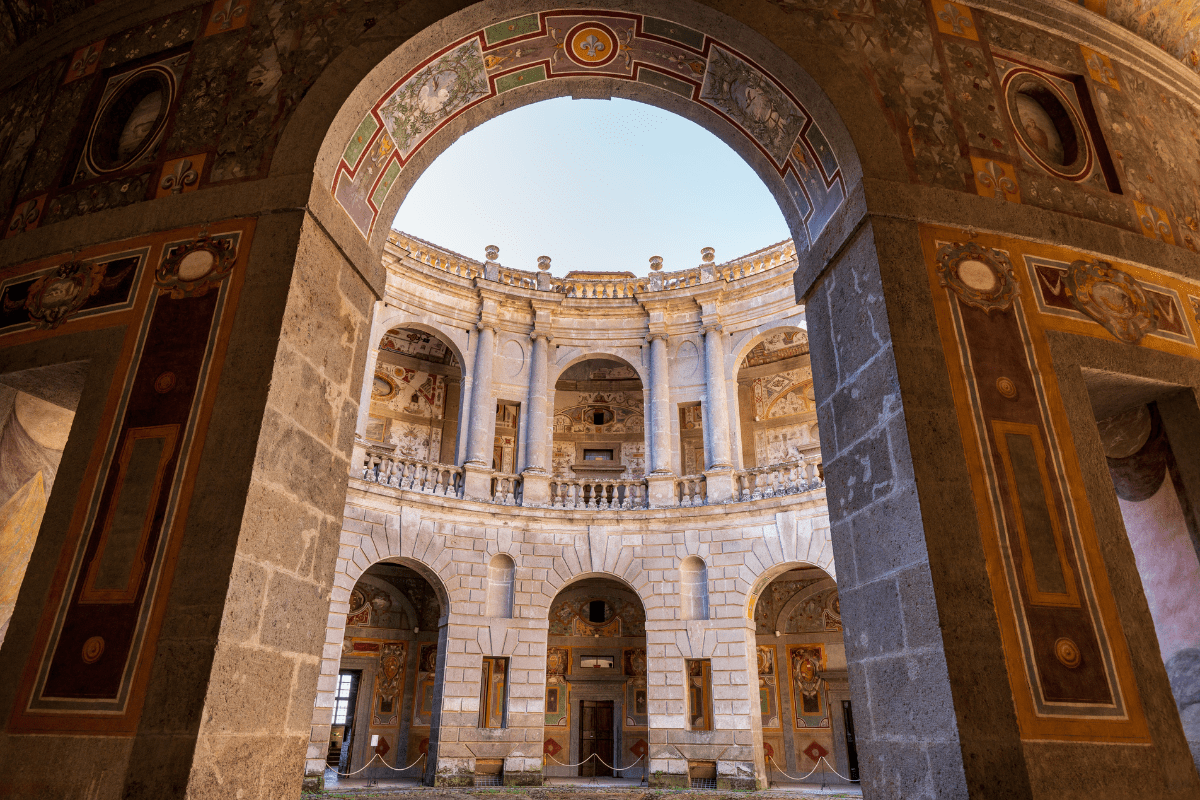
The circular courtyard with its frescoed arcades
The building is more than 30 meters high on five floors and is divided into two zones: the summer zone to the north and the winter zone to the southwest.
Palazzo Farnese: the most beautiful frescoes
The interiors of Palazzo Farnese are rich in art and beauty and are characterized by extraordinary rooms and marvelous frescoes, each with its own meaning. One of the most striking places is the Stanza dei Fasti Farnesiani, where frescoes painted by Taddeo Zuccari narrate the history and the most glorious moments of the powerful Farnese family, from their military successes to their important political alliances. A real treasure of history!
La Sala dei Fasti Farnesiani - Photo by Jean-Pierre Dalbéra, Creative Commons
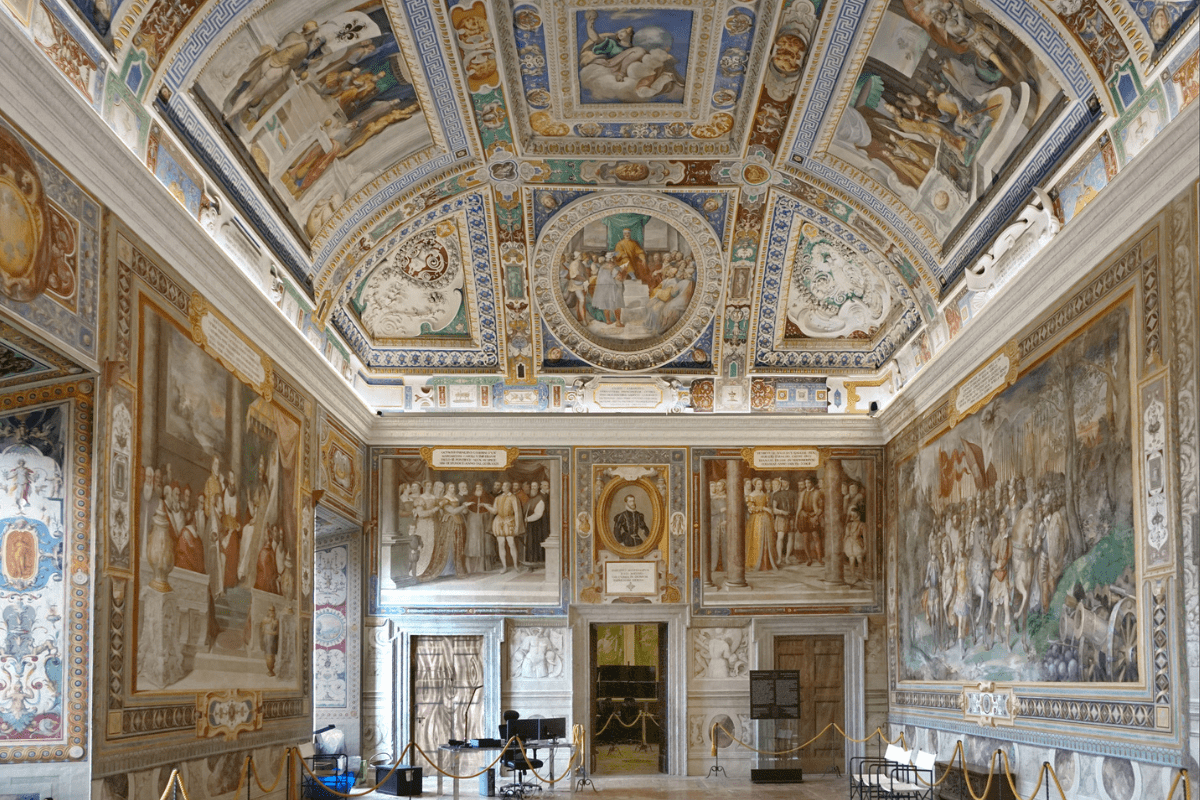
The sala dei Fasti Farnesiani relates the events of the powerful dynasty but also the history of Italy and Europe. Photo by Jean-Pierre Dalbéra, CC.
The Hercules Room shows representations depicting the exploits of the mythological hero. Of particular interest is the character's connection to the surrounding area. According to local legend, some shepherds challenged Hercules to a test of strength. So he drove a spear into the ground, giving rise to the beautiful Lake Vico.
Another very emblematic space is the Stanza del Mappamondo, which inspired the creation of the Galleria delle Carte Geografiche in the Vatican Museums. On the walls you can see the four parts of the world discovered by the greatest navigators of the time (Marco Polo, Christopher Columbus, Ferdinand Magellan, Ferdinand Cortez and Amerigo Vespucci), while on the back wall is represented the entire world map.
World Map Room - Photo by Garystockbridge617, CC
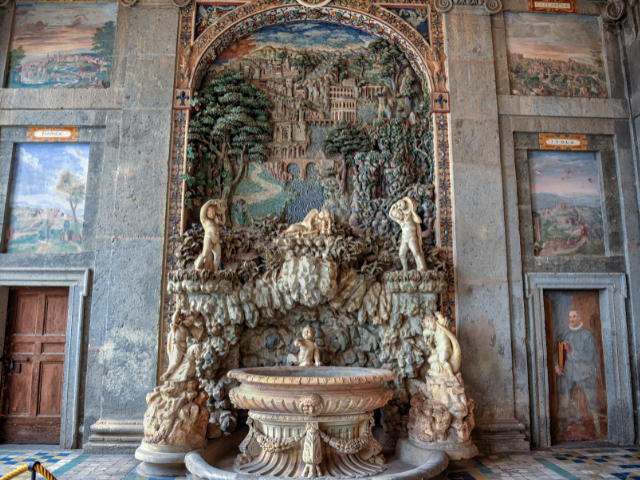
The vault of the Hall of Hercules - in the panels, the representation of the hero's myth
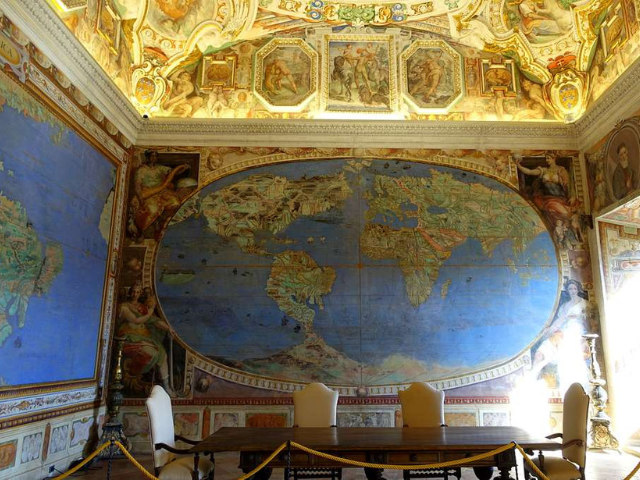
The World Map Room and the planisphere - photo by Garystockbridge617 CC
These are just some of the fantastic rooms that can be seen inside Villa Farnese. The itinerary begins in the Stanza delle Guardie, continues through the wonderful Scala Regia and leads to the Piano Nobile, the only one that is currently open to the public. In total, you will pass through fourteen rooms arranged around the circular courtyard.
Renaissance Gardens
The gardens are a true jewel of Renaissance landscaping, characterized by their geometric precision and the presence of aquatic elements. They were impeccably designed, with a perfect layout that delighted the cardinal's numerous guests during their walks.
Inside, the vegetation perfectly blends with sculptures and fountains, terraces and staircases. The most outstanding places are the Grotta dei Satiri and the Grotta dei Tartari in the lower gardens; the Fontana del Giglio and the Casina del Piacere in the upper gardens. The Casina del Piacere has frescoed rooms that cannot be visited today, but it is worth remembering that it was the summer residence of the President of the Republic Luigi Einaudi and hosted Prince Charles of England in 1995.
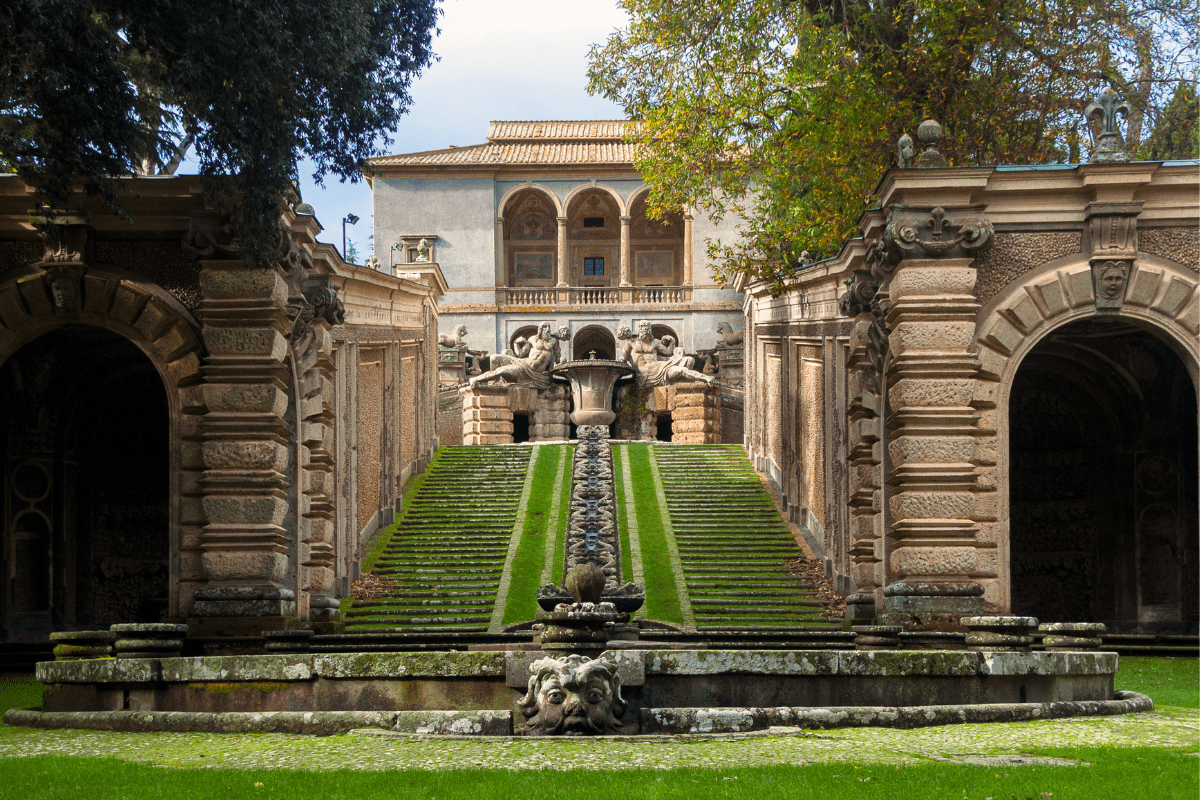
Giardini Alti of Palazzo Farnese and the Fontana del Giglio
We wish you a very pleasant visit to Palazzo Farnese, where history, art and nature will guide you in a unique experience! Don't forget to have a walk through the charming streets of Caprarola and to explore the wonderful surrounding attractions: we will talk about them in the next article.
Enjoy your journey!
Useful information
- TIMETABLES
The tour of the palace takes about an hour and a half;
Entrance to the gardens:- January: last admission 3:00 p.m. (closing 4:00 p.m.);- February: last admission 3:30 p.m. (closing 4:30 p.m.);- March: last admission 4:00 p.m. (closing 5:00 p.m.);- April through September: last admission 6:00 p.m. (closing 7:00 p.m.);- October: last admission 5:00 p.m. (closing 6:00 p.m.);- November and December: last admission 3:00 pm (closing 4:00 pm).Opening Hours:
Tuesday through Sunday, 8:30 a.m. to 7:30 p.m. (ticket office closing at 6:45 p.m.).
- PRICES
- Full: € 10,00Full without gardens: € 8,00Reduced (between 18 and 25 years): € 2,00Free (up to 18 years old)



 PORT MOBILITY CIVITAVECCHIA
PORT MOBILITY CIVITAVECCHIA


















